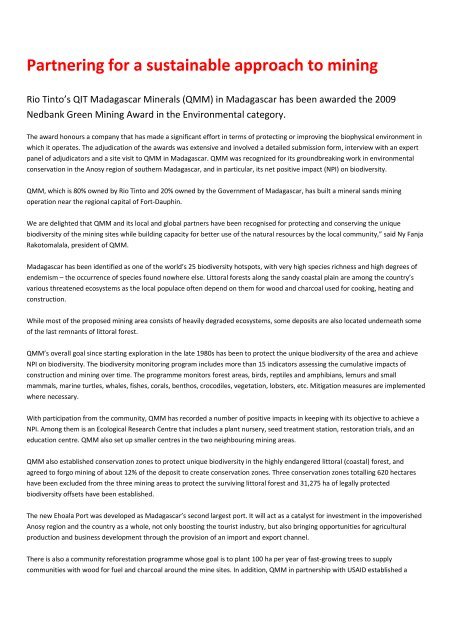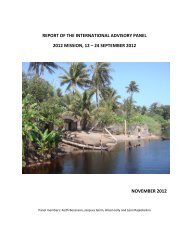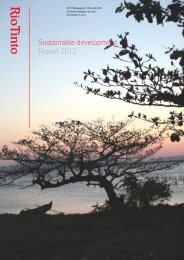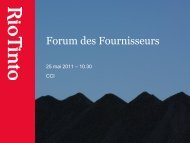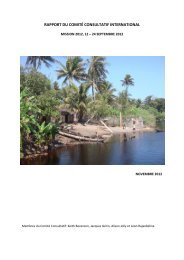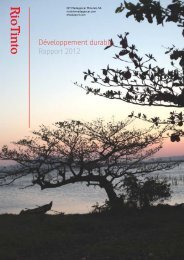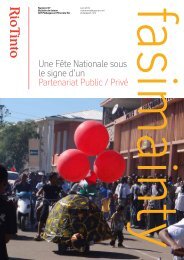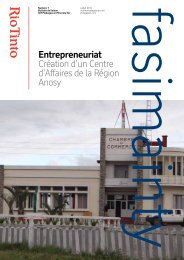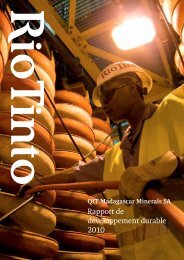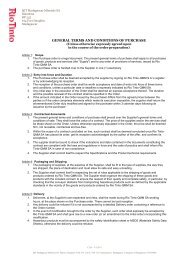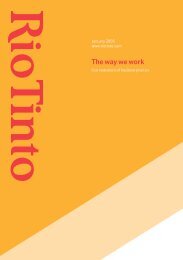Download PDF - Rio Tinto - Qit Madagascar Minerals
Download PDF - Rio Tinto - Qit Madagascar Minerals
Download PDF - Rio Tinto - Qit Madagascar Minerals
Create successful ePaper yourself
Turn your PDF publications into a flip-book with our unique Google optimized e-Paper software.
Partnering for a sustainable approach to mining<br />
<strong>Rio</strong> <strong>Tinto</strong>’s QIT <strong>Madagascar</strong> <strong>Minerals</strong> (QMM) in <strong>Madagascar</strong> has been awarded the 2009<br />
Nedbank Green Mining Award in the Environmental category.<br />
The award honours a company that has made a significant effort in terms of protecting or improving the biophysical environment in<br />
which it operates. The adjudication of the awards was extensive and involved a detailed submission form, interview with an expert<br />
panel of adjudicators and a site visit to QMM in <strong>Madagascar</strong>. QMM was recognized for its groundbreaking work in environmental<br />
conservation in the Anosy region of southern <strong>Madagascar</strong>, and in particular, its net positive impact (NPI) on biodiversity.<br />
QMM, which is 80% owned by <strong>Rio</strong> <strong>Tinto</strong> and 20% owned by the Government of <strong>Madagascar</strong>, has built a mineral sands mining<br />
operation near the regional capital of Fort‐Dauphin.<br />
We are delighted that QMM and its local and global partners have been recognised for protecting and conserving the unique<br />
biodiversity of the mining sites while building capacity for better use of the natural resources by the local community,” said Ny Fanja<br />
Rakotomalala, president of QMM.<br />
<strong>Madagascar</strong> has been identified as one of the world’s 25 biodiversity hotspots, with very high species richness and high degrees of<br />
endemism – the occurrence of species found nowhere else. Littoral forests along the sandy coastal plain are among the country’s<br />
various threatened ecosystems as the local populace often depend on them for wood and charcoal used for cooking, heating and<br />
construction.<br />
While most of the proposed mining area consists of heavily degraded ecosystems, some deposits are also located underneath some<br />
of the last remnants of littoral forest.<br />
QMM’s overall goal since starting exploration in the late 1980s has been to protect the unique biodiversity of the area and achieve<br />
NPI on biodiversity. The biodiversity monitoring program includes more than 15 indicators assessing the cumulative impacts of<br />
construction and mining over time. The programme monitors forest areas, birds, reptiles and amphibians, lemurs and small<br />
mammals, marine turtles, whales, fishes, corals, benthos, crocodiles, vegetation, lobsters, etc. Mitigation measures are implemented<br />
where necessary.<br />
With participation from the community, QMM has recorded a number of positive impacts in keeping with its objective to achieve a<br />
NPI. Among them is an Ecological Research Centre that includes a plant nursery, seed treatment station, restoration trials, and an<br />
education centre. QMM also set up smaller centres in the two neighbouring mining areas.<br />
QMM also established conservation zones to protect unique biodiversity in the highly endangered littoral (coastal) forest, and<br />
agreed to forgo mining of about 12% of the deposit to create conservation zones. Three conservation zones totalling 620 hectares<br />
have been excluded from the three mining areas to protect the surviving littoral forest and 31,275 ha of legally protected<br />
biodiversity offsets have been established.<br />
The new Ehoala Port was developed as <strong>Madagascar</strong>’s second largest port. It will act as a catalyst for investment in the impoverished<br />
Anosy region and the country as a whole, not only boosting the tourist industry, but also bringing opportunities for agricultural<br />
production and business development through the provision of an import and export channel.<br />
There is also a community reforestation programme whose goal is to plant 100 ha per year of fast‐growing trees to supply<br />
communities with wood for fuel and charcoal around the mine sites. In addition, QMM in partnership with USAID established a
egional nursery in 2005 to provide a sustainable source of fuel for the local population and thereby reduce pressure on the native<br />
littoral forest remnants. To date, more than 1000 ha have been reforested with more than 1 million trees.<br />
“Of course we have not done this alone. Active engagement with <strong>Madagascar</strong> government, local, national and international<br />
stakeholders has been fundamental to the success of the project. QMM worked closely with numerous specialist environmental<br />
organisations researching the region’s biodiversity. An independent biodiversity advisory committee was formed in 2001 to review<br />
the biodiversity strategy,” said Manon Vincelette, head of community affairs, biodiversity and sustainable development at QMM.<br />
www.riotinto.com


